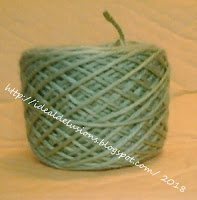With the advance to “Center Pull Skeins” the art of winding a hank or even a skein of yarn into a ball is no longer a priority for many and appears to have become a lost art..
When yarn is wound at the mill the machines maintain a preadjusted tension to create a smooth even Skein. With a yarn winder it is easy to control your tension and mimic that smooth wind into a lovely cake. But winding by hand is a whole different craft and many new artists today do not realize part of the Art of Crochet is learning how to correctly roll a ball of yarn.
This post is not to discuss the reason we wish to hand wind our yarn into a ball nor the preparation required in order to be able to do so. This is strictly on how to correctly hand wind your yarn to maintain the quality for future use.
Yarn is flexible and resilient, it stretches and snaps back. Pull it hard and see how skinny it gets before it breaks. Many yarn’s today are treated with sizing chemicals to help them hold their shape.
Even if you do not need or want to pre-wind your yarn, at some point in time a center pull skein may eventually collapse into itself or you will finish your project, creating a need to wind the remainder, perhaps into a ball.
I searched the internet looking to see the recommended method for winding a ball of yarn and I did not agree with what I found. All of the methods are similar but I did not see one I considered correct in regard to maintaining the viability of the yarn. So this is the way I do it when I am not where I can access my yarn winder.
I am right handed so I start to wind on the fingertips of my left hand. When I have about 20 wraps, I pulled the wrapped yarn from my fingertips and lay it on my extended fingers.
Using my thumb to hold it in place, repeat the wrap, over the yarn and my fingertips. After about 20 wraps I gently slide my fingers out and repeat the process.
It does not matter if you wrap over 1, 2 or 3 fingers, the ideas is to create some “snap back” space so your yarn will not be drawn to its full potential and have to stay that way for long periods of time.
I continue to repeat the turn, wrap and reposition of the now growing ball on my fingers, always wrapping around both the yarn and my fingertips, until the loose yarn is exhausted.
Then taking a crochet hook I slide it under a few strands of yarn and pull the working end of the yarn under and though to keep it from coming undone.
The end result should be a soft squishy ball of yarn that will flex in your hand if you squeeze it. If your ball of yarn is hard, you have wound it too tightly, stretched it too much and if stored for a long time, you may find it has lost its resilience and will not preform the way you expected.
Related Post Link What I Learned About Yarn Winders

.jpg)






 Print Friendly
Print Friendly